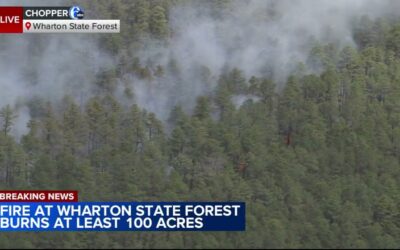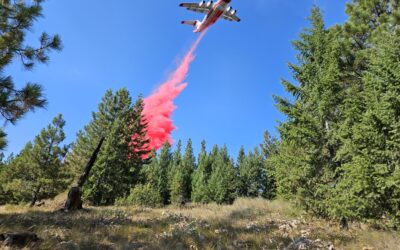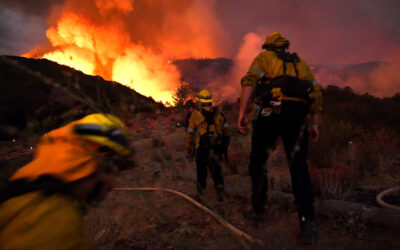How do houses burn down? There are two main ways: from an internal ignition source and from an external ignition source. Building codes focus primarily on protecting houses from internal ignition sources, but wildfires—forest fires, vegetation fires, and wildland urban interface (WUI) fires—impinge on houses from the exterior. Yet, building codes have taken only limited steps to guard against external ignitions and, as we shall see, there is much more to be done.
Wildfires around the globe are getting more severe, including those in the United States. Of special interest are the severe wildfires in California, which have resulted in such disasters as the November 8, 2018, Camp Fire, which destroyed much of the town of Paradise and killed more than 80 individuals.1 Although it takes a whole range of strategies to reduce the potential for such losses, an important component of life safety is preventing the ignition of houses. Thus, it becomes important to see what has been achieved in this area and what still remains to be done.
The main focus involves research and construction practices needed to protect houses located in the forest or in the WUI. But it is also important to reduce the potential for house ignitions from urban conflagrations, which similarly attack houses from the exterior. Here, the urban conflagrations of interest are those that start with wildfires and then progress to urban communities so that the preponderant burning is in an urban setting, not in the WUI.
Here, again, California provides an unfortunate example. The Tubbs Fire2 of October 2017 burned sizable portions of three counties. But in the City of Santa Rosa, which is an urban area, it turned into an urban conflagration that leveled much of the Coffey Park neighborhood.

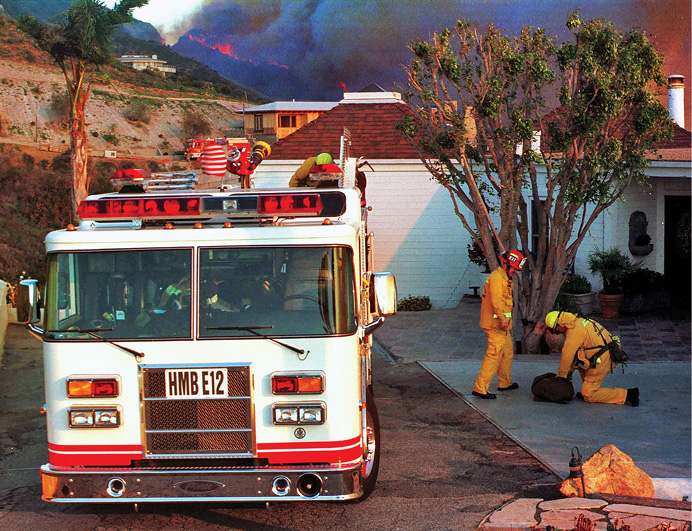
(1) Photos by Keith D. Cullom/www.fire-image.com.
Early History
Until around 1970, forest fires and house fires were considered two different, totally unrelated phenomena addressed by professionals whose professions did not overlap. In 1971, after major California fires in 1970, Carl Wilson3 suggested, “The commingling of urban and rural fires is a national problem.” Very shortly after that, in 1974, Pres Butler4 wrote what effectively was the first engineering analysis of the WUI problem. He went beyond acknowledging the existence of the problem to outlining potential remedies; we will return to this later. However, I emphasize his conclusion here: “Every person whose home is exposed to a wildland environment and hence must depend on the interface to protect himself and his possessions has an obligation to study the penalties of ignorance.” This injunction, however, is only meaningful if solutions are available to such “every person.” Thus, it is crucial to consider what is known and what has yet to be learned.
How Exterior Fires Ignite Houses
Houses, or any other structures, can be ignited primarily in three ways5: firebrands, radiant heat, and direct flame contact. Firebrands6,7 are small particles (but, in some instances, they may be sizable) that break off a burning item, become airborne, then travel to some remote site where they land. “Embers” is sometimes used as a synonym but, for this term, travel through the air is not necessarily implied. Any burning item emits radiant heat, whether it is a tree, a house, or something else that is combustible. For the discussion here, we will assume that the flames from which the radiant heat is coming are remote from the target. Spread from direct flame contact occurs when new combustible material progressively ignites from the existing fire. An example would be a house that is surrounded by dry vegetation and ignites directly from flaming vegetation. But, in the case of an urban conflagration, this may be a flamefront from existing burning houses that attacks a new structure. Ignition of houses by means of direct flame contact can generally be studied only by examining case incidents, since the scale is too large to conduct realistic experiments.
Despite their lack of visual drama, firebrands are the number-one cause of houses burning down in the WUI.5,6 This is how it happens: “The embers can gain entry to a house through broken windows or gaps in and around the wall or roof cladding and then ignite the contents. Embers lodge on and ignite horizontal timber in decks, steps, and windowsills or are blown up against and ignite timber used at ground level for [stilts], gap-boards, posts, and steps.”8 Furthermore, the single largest reason firebrands burn down houses is firebrands lodging in a wood deck.9
What Is to Be Done?
Preventive strategies may be grouped into two broad categories: (1) vegetation management, and (2) fire safety improvements to houses. Both are necessary, but #1 is widely appreciated, while #2 is much less so. Thus, the focus here will be solely on #2.

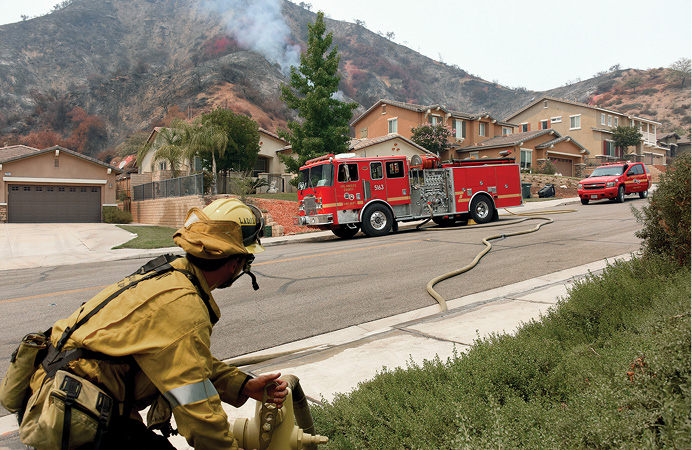
(2)
The first significant study on the WUI, authored by Butler4 in 1974, found the following: “All houses examined in the survey had an Achilles heel where fire could gain entry. Very few structures had both noncombustible roofs and exterior walls. Many buildings had stucco walls and a few had asbestos,10 cement, or aluminum siding, but very few combined these materials with tile or asbestos shingle roofs. In areas where the fire attacked both walls and roofs, the majority of the buildings had roofs of tar and gravel, composition shingles, or cedar shakes. The few buildings with noncombustible exteriors were conspicuous for their survival.”
Thus, already in 1974, the basic tenet was clear: To avoid becoming a victim of a wildfire, a building has to have a “noncombustible exterior.” From today’s perspective, this statement requires only modest modification. Today, we would explain that the building’s exterior must be ignition-resistant. There is a substantial background, however, which is needed to explain this.
Mass Fires, Urban Conflagrations, and Firestorms
An urban conflagration is a fire event where fire consumes large portions of some urbanized settlement because of the inability to mount an effective fire attack. A mass fire is a similar event, except the target is not specified—it can be wildland, city, or some other expanse of combustibles. These can be compared to the related concept of a firestorm. The latter also entails consumption of large portions of some territory but with the added feature that the combustion is so strong as to create its own weather patterns.
By necessity, most of the studies of mass fires have been retrospective. One of the few controlled experiments in mass fires was Project Flambeau, a research program conducted by the Office of Civilian Defense (OCD), the U.S. Forest Service (USFS), and some additional agencies from 1962-1969. This was conducted before the availability of modern-day sensors; thus, the crucial question was not addressed: What is the heat flux profile at locations where a threatened house might be situated?
Historically, the three most-studied mass fires have been the firestorms that engulfed Hamburg, Hiroshima, and Nagasaki during World War II. These can teach certain aerodynamics-related lessons but, of course, the context is rather different from peacetime wildfires. There has certainly been no shortage of peacetime massive wildfires, especially in California. But, interestingly enough, the investigations that ensue rarely have much value for advancing the knowledge on how to build in a more ignition-resistive manner. As common with other fire types,11 the main focus tends to be to determine if there has been a perpetrator or a negligent party that was the cause of the fire. A few useful counterexamples have been the studies of those researchers who approached the problem from the perspective of learning lessons concerning how to build better.12, 13, 14, 15
Why Are Burned-Down Houses Not Rebuilt to Be Ignition-Resistant?
The Australians attempted to find out the answer to this question5: “Various reasons were put forward. Some thought that such features are not effective, especially in bushfires of the magnitude and severity that occurred on ‘Ash Wednesday’ 1983. Others were not willing to add to the cost of their houses, and some relied on the building regulations, which do not detail special requirements for bushfire-prone areas, as a yardstick for the rebuilding.” Thus, we see two issues being raised: (1) lack of knowledge of what to do, and (2) fear that costs might be high.
Because of the California building code requirements for fire hazard severity zones, rebuilding may be somewhat better than the existing housing stock. After the Tubbs Fire, David Guhin, a Santa Rosa city official, stated16: “Yeah, I think where we live, in most places, natural disasters are common. And so what we try to do is develop zoning and rules to mitigate those impacts. So what’s different is when homes are built before these fire codes went into place. And so all the new homes are coming back much more resilient—the protections, the mitigations, the setbacks. Fire sprinklers are required in all homes at this point.” In this connection, it must be pointed out that while fire sprinklers are outstandingly effective for internal fires, their effectiveness against wildfire attack is likely minimal. It also needs emphasis that it was not required for rebuilding in Santa Rosa to comply with the California building code’s ignition-resistant building requirements.

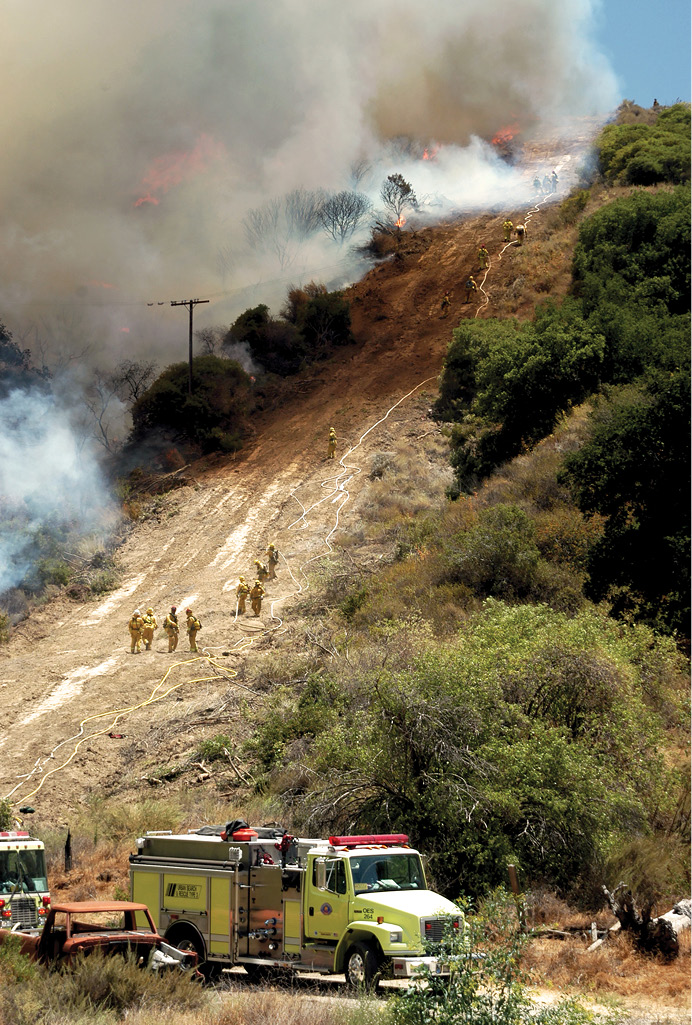
(3)
Australian Guidance
The first handbook (albeit brief) on how to make houses ignition-resistant was published in 1993 by Ramsay and Dawkins.17 This was viewed as a supplement to, and an interpretive guide for, AS 3959 (see below). The authors started by pointing out that safety measures can be grouped into four categories: the construction materials used, the architectural design, the location of the structure on the site, and the proximity and the type of nearby vegetation. These are still considered today the four primary categories that should be addressed by an effective effort to make a structure ignition-resistant.
The basis for the Ramsay/Dawkins handbook was the Australian Standard, “Construction of Buildings in Bushfire-Prone Areas,” first issued in 1991, with subsequent editions being in 1999, 2009, and 2018. This document classifies geographic locations according to Bushfire Attack Levels (BALs), of which there are six, ranging from “Low” to “FZ” (extreme). The analogous action was achieved in California in the form of the publishing of the Fire Hazard Severity Zones Maps. In the Australian scheme, there is a correlation between the BALs and the notional radiant heat flux levels expected from the fire, with FZ corresponding to heat fluxes greater than 40 kW m-2 and flame contact likely. For each of the six BALs, separate construction requirements are provided. The main problem is that research to support the requirements was lacking. But, of more concern, the standard was deemed to be inadequate18 both by CSIRO (Australia’s premier institution for conducting bushfire research) and the association of Australian fire authorities, organizations focused on practice, not theory.
What Was Done in California to Date
In 1993, California received an initial grant from the Federal Emergency Management Agency to start research on engineering solutions that could lead to ignition-resistant structures.19 The first major achievement was the publication in 1996 of California’s I-Zone Manual.20 Then, during 2000-2001, the former University of California Forest Products Laboratory (UC FPL)21 was funded to develop a series of tests for exterior building components potentially liable to wildfire attack. These tests formed the basis of changes propounded by the California State Fire Marshal (CSFM) for the California Building Code and the California Fire Code during 2005-2006. This resulted in the implementation of WUI building code provisions, with Phase I becoming effective December 1, 2005, and Phase II January 1, 2008. The California requirements are periodically revised as the California Building Code is reissued on a three-year cycle, and some of the later changes have been explained by the CSFM.22 The intent of the California WUI code provisions was to allow new-construction buildings to achieve a certain measure of ignition resistance. This is further explored below, but it may be noted here that these benefits are largely speculative even though well-intentioned. Thus, there is clearly much work left to do.
The California I-Zone Manual
Formally titled California’s I-Zone—Urban/Wildland Fire Prevention & Mitigation, this was the first major (308-page) book published on the WUI topic, appearing in 1996.23 Some 24 years later, it remains the only broad-based publication in this field, although of course lacking any information on the CSFM WUI provisions, which came later. It covers planning, zoning, history, vegetation management, and other diverse aspects (although not WUI firefighting24). Of relevance here are a number of chapters dealing with survival of structures endangered by WUI fires.
One important point made in the manual is that, unlike Australia or some other countries, already in the early 1900s, California builders developed a penchant for wood shake roofing. Apart from thatch, this is the most irresponsible type of roof that can possibly be put on a building and was clearly identified as a menace during the 1923 Berkeley Hills Fire.25 A detailed analysis26 of house losses for the 1990 Paint Fire showed that houses with wood roofs had a 19% chance of survival, while those with noncombustible roofs had a 70% chance. Even more strikingly, the authors identified that there was an 86% chance of survival for houses having a noncombustible roof plus a 30-foot brush clearance; by contrast, there was a 4% survival for houses having neither of these measures. However, it bears noting that a 30-foot clearance may be more realistic for houses in the forest than in the WUI. In modern building practice in WUI areas, houses often have much less than a 30-foot clearance exterior wall to exterior wall, for two adjoining houses.
The manual also identified the following27: “The lack of empirical data for ignition-resistant construction requires the [AHJ] to evaluate building materials and installation on a case-by-case basis.” The subsequent adoption of WUI provisions into the California building code makes some of the requirements objective but not necessarily successful.
The UC FPL Research Program
The tests encompassed within the CSFM WUI code provisions were based on a research program conducted by Professor Frank Beall and Dr. Stephen Quarles at the former UC FPL. Unfortunately, no final report was published, but several papers28,29,30,31,32,33 describe the basic outline of the work that was done. The array of tests (not all from FPL work) that was eventually adopted into the California WUI code provisions is shown in Figure 1. The tests were introduced into the California codes effective in 2008 except for SFM 12-7A-5, which became effective in 2011.
Figure 1. CSFM and ASTM Tests for Ignition-Resistant Construction Products
Component | CSFM Test | ASTM Version |
Siding | SFM 12-7A-1 | ASTM E2707 |
Windows | SFM 12-7A-2 | ASTM E2010 (withdrawn) |
Eaves | SFM 12-7A-3 | ASTM E2957 |
Decking | SFM 12-7A-4 and -4A | ASTM E2726/E2726M |
Ignition-resistant material | SFM 12-7A-5 | ASTM E2768, ASTM D2898 |
Roofing | — | ASTM E108 |
Vents | — | ASTM E2886/E2886M |
Vent testing was not included as a SFM test but was later developed as ASTM E2886/E2886M, based largely on later research at the Insurance Institute for Business & Home Safety (IBHS) and at the National Institute of Standards and Technology (NIST).34 Subsequent to issuing the CSFM WUI code provisions, test development continued at several institutions.35,36,37 But notwithstanding all this testing and research, it is of serious concern that the CSFM/ASTM tests are, in many cases, inadequate and conforming products are not reasonably ignition-resistant. This is perhaps easiest to see for the case of wood decks. Industry influence resulted in a standard that allows redwood decks untreated with any fire-retardant chemical to be classified as38 “a fire-safe decking product.”

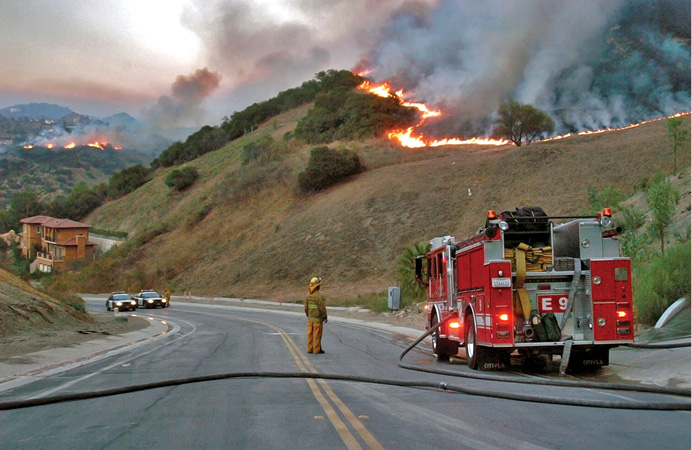
(4)
Other U.S. Research Activities
Apart from the activities in California, there have been two significant research programs on ignition resistance of structures in the United States, one headed by Jack Cohen at USFS, the second by Sam Manzello at NIST.
USFS research. During the late 1990s through the early 2000s, Jack Cohen and his colleagues created a structural ignition assessment model, which they called SIAM.39 This quantifies the heat flux/time relationship needed for ignition from radiant heat transfer. On the basis of this, Cohen proposed calculations for safe distance from a crown fire.40,41 This may solve one problem, but it only pertains to one of the three modes of ignition. Furthermore, it only serves to quantify, not to prevent. Unlike the CSFM effort, his study did not lead to schemes for enforcing ignition-resistant building construction. Furthermore, the model was never finished and was not released for use. Historically, the USFS program was of most value for its educational outreach, which was significant, and was the primary one occurring in the United States during that time.
NIST research. The largest laboratory research effort aimed at controlling ignitions at the WUI has been that organized by Sam Manzello at NIST. The work was started in 2005 and continues to this day. Manzello realized that WUI fires, if they are of any significance, are wind-driven. Yet, the conventional laboratory instrumentation for studying fire dynamics is based on still-air conditions. NIST does not have a large-scale wind tunnel that could be used for conducting fire experiments. Thus, Manzello formed an alliance with two Japanese institutions, the Building Research Institute (BRI) and the National Research Institute of Fire and Disaster (NRIFD), which have the types of wind tunnels needed to support such experiments. As a result, this research came to be co-headed by Manzello and the NRIFD’s Sayaka Suzuki. More recently, Manzello, Suzuki, and other WUI researchers evolved the first edition of an Encyclopedia of Wildfires and Wildland-Urban Interface Fires42 where research findings in this area have been consolidated.
The NIST focus came to be on firebrands, since this research can be done in a wind tunnel. A 2011 report43 summarized the extensive research that had been completed to that point. Using an ember generator that they named the “NIST Dragon,” the researchers studied firebrand ignitions of roof, vents, wall claddings, eaves, and windows. They also studied more general aspects of ignition of combustibles by firebrands. Later, the researchers developed a simplified44 “Baby Dragon.”

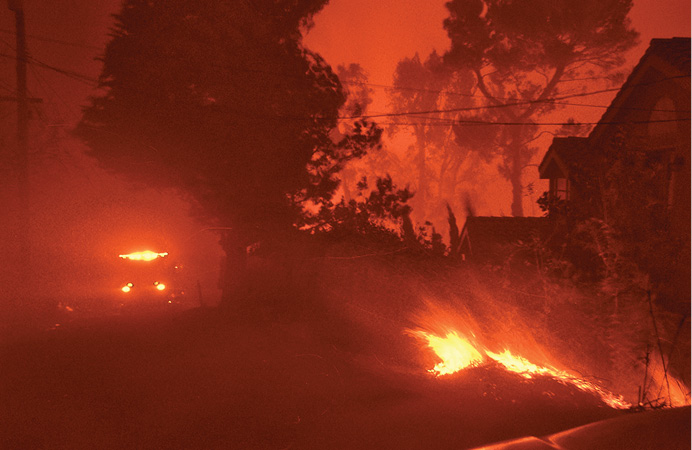
(5)

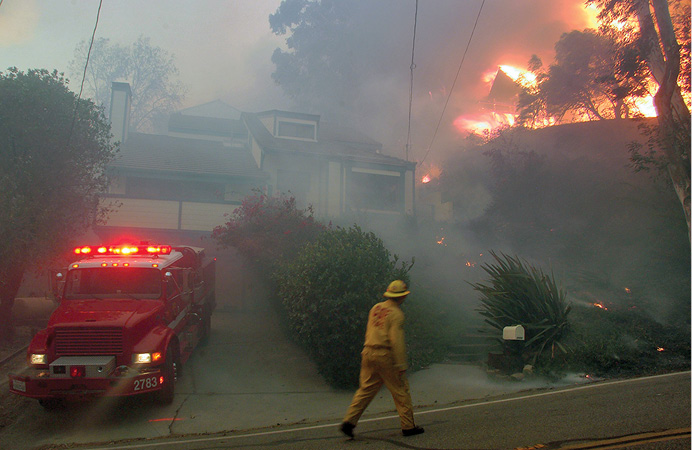
(6)
Other U.S. Codes/Standards
Apart from the very specific WUI provisions put into California’s building and fire codes, two other well-known documents have been issued on WUI protection: one by the National Fire Protection Association (NFPA) and one by the International Code Council (ICC). Some comparisons between the provisions of the three main documents have been published.45
NFPA 1144. The NFPA standard46 has a very long history, originally being published as “Fire Protection and Prevention for Summer Homes in Forested Areas” in 1935. Its scope is roughly similar to the CSFM regulations in terms of issues that are addressed, although the actual material requirements are different. But because adoption of the standard has been limited, its impact has also been limited. It may also be noted that the standard has adopted neither the CSFM standards nor their ASTM equivalents, except for the ASTM E84 Steiner Tunnel test. Consistent with this, there is basically no technical literature that references the NFPA standard. The few references that do exist mainly recognize its existence but do not discuss its efficacy. Compared to the Australian standard, the NFPA standard is a much more rudimentary document.
International Wildland-Urban Interface Code (IWUIC). This code47 is an evolution of an earlier Urban-Wildland Interface Code (UWIC). It also adopts the concept of “ignition-resistant construction” but elaborates it into three classes of protection (Ignition Resistant Classes). The technical content of this code is brief and, similar to NFPA 1144, none of the CSFM tests or their ASTM equivalents are invoked. Because it is a “model” code, many of the details are left for the jurisdiction adopting it to sort out. Compared to the Australian standard, the IWUIC is a much more rudimentary document.
What Is Still Needed
The funding for research on wildfires is very limited,48 and the overwhelming fraction of what is funded goes to ecological or social sciences research, not toward engineering studies and almost never toward studies involving buildings. This needs to change. Engineering research needs to start getting funded, and foremost in this area has to be studies on building performance in fires.
The visions of catastrophic urban mass fires, the Tubbs and Camp Fires, are still vivid in California. While the initial sequence was that of WUI fires, eventually the fires became urban conflagrations. As noted above, research on urban conflagrations is very scarce. It is useful to reiterate here that the conventional approach to investigating fires—determine if there is a perpetrator or a responsible party—may be necessary, but it is insufficient. When it comes to hugely destructive fires, the most important objective should be to learn how to reduce the likelihood of recurrence. This has not been the mindset, but the mindset should be reassessed. A modest research base exists, but more is needed.
The CSFM WUI regulations are now more than a decade old. It would be appropriate to examine how effective they have been and potentially what can be done to strengthen them. Specifically, what engineers call “validation” is absent. Validation is a technical inquiry made to determine if a given scheme does what it claims to do. The UC FPL scientists put in their best effort to produce innovative, first-generation tests based, in most cases, on a blank slate approach. How successful were they? What are the gaps? And how might they be filled in? Is an entirely different approach needed in certain cases? The latter might be the case for firebrand attack laboratory simulations. The UC FPL research was completed before NIST and IBHS researchers even began their work. Thus, it could not have any input from that work. Later, the NIST work was used to develop the ASTM standard for vents, but standards for decks and ignition-resistant materials might also well benefit from being reexamined in view of the NIST and IBHS research.
Fences and any other outdoor or detached combustibles are another area where focused research is needed. NIST and IBHS have already conducted some research specific to combustible fence ignitions.49,50 However, this needs to be tied back to general structure safety.
Should an effort be made to develop effective, economical shutters for protecting windows? Certainly, as a minimum, it is worth exploring this concept. In the United States, commercial products for such purposes are rare, and no testing methodology is available, making such protection a moot point. But it is entirely possible this could be a big step in safety improvement.
What about “stay and defend” (also known as “stay and protect”)? Currently, this concept is rare in the United States and Canada. Yet, in Australia, it has been seriously considered for a long time.51,52,53,54,55 In fact, a recent search of literature on this topic indicates that more than 600 publications have addressed the “stay and defend” topic. Houses in Australia are much more commonly built with noncombustible exterior materials, unlike in America. Certainly, traditional (unprotected) American houses are not good candidates for “stay and defend.” But what about houses using ignition-resistant materials for their entire exterior? The question deserves thoughtful investigation. Furthermore, the Australian policies have typically expressed a dichotomy: Prepare to stay and defend or leave early.

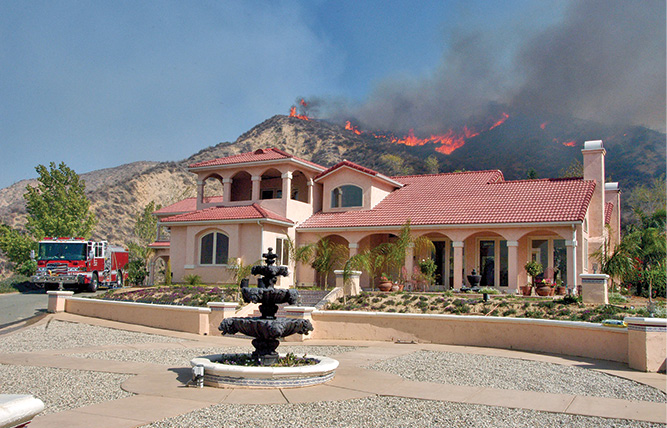
(7)

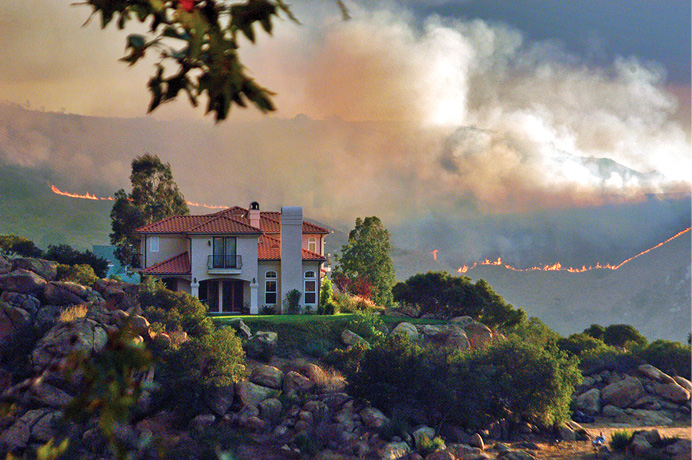
(8)
In the case of U.S. (and California) housing, this may be too simplistic. The Australians themselves realize that more than 50% of the population rejects either alternative. Mainly, they dither and wait for the situation to come into clearer focus.56 The latter, of course, is hardly recommended as a course of action. Prepare to stay and defend is adopted as a strategy by a very small segment of the population even in Australia, and public authorities have had—and will continue to have—reservations about recommending it, for obvious reasons. But there is no downside (except for the modest costs) to leaving early yet leaving behind a “self-defending” house. And it is of interest that the USFS published a paper57 acknowledging that stay and defend should be an option that is available to residents, at least under some circumstances.
At least one California jurisdiction, the Rancho Santa Fire Protection District,58 has overtly espoused a shelter-in-place philosophy. This was made possible by building regulations and inspection procedures in that jurisdiction that go beyond the minimum required by the California Building Code. The feasibility of pioneering this approach may have been, at least partly, because of the nature of the Rancho Santa Fe community, which is one of the most affluent in the entire country.59
The CSFM concept of “ignition-resistant” houses is pivotal to any potential policies of stay and defend or shelter-in-place. But it is also important simply to reduce the risk of devastated communities, even if no changes are made in evacuation policies. Thus, it is important that it be extended to its logical fruition. On a broad basis, two things are necessary: (1) validation of the tests and the requirements, together with improvements in any areas where deficiencies are seen; and (2) development of ideas on how to extend the protection concepts to existing housing. If improved construction techniques are solely reserved for new housing, it will take a century before a major part of the housing stock is upgraded.
The Australians have already explored the costs that would be needed to upgrade existing houses to AS 3959 level.60 The average house would require $24,600, with the range being $8,500 to $47,000 (all in Australian dollars). For new houses, compliance was estimated17 as $22,000 (AUD). Recently, a cost-difference study was completed in the United States.61 Here, the startling conclusion was that the new-construction cost for building according to ignition-resistant requirements would be essentially nil. The study did not quantify the costs for retrofit.
Acknowledgments
This article was reviewed by Ethan Foote, Steve Quarles, Samuel Manzello, Mark Novak, and Todd McNeal. Their helpful comments are acknowledged.
References:
1. St. John, P., et al., “California Fire: What Started as a Tiny Brush Fire Became the State’s Deadliest Wildfire. Here’s How.” Los Angeles Times (Nov. 18, 2018).
2. Roman, J., “Build. Burn. Repeat?” NFPA J. 112:1, 24-33 (Jan./Feb. 2018).
3. Wilson, C.C., “Commingling of Urban and Forest Fires—A Case Study of the 1970 California Near-Disaster,” Fire Research Abstracts & Reviews 13:1, 35-43 (1971).
4. Butler, C.P., “The Urban/Wildland Fire Interface,” paper presented at the Western States Section, The Combustion Institute (1974); reprinted Fire Prevention Notes, No. 10, California Dept. of Forestry (Sep. 1976).
5. Ramsay, G.C., McArthur, N.A., and Dowling, V.P., “Building Survival in Bushfires,” Fire Science ’86, Institution of Fire Engineers, Western Australian Branch (1986).
6. Babrauskas, V., Ignition Handbook, Fire Science Publishers/Society of Fire Protection Engineers, Issaquah WA (2003).
7. Babrauskas, V., “Firebrands and Embers,” Encyclopedia of Wildfires and Wildland-Urban Interface (WUI) Fires, S.L. Manzello, ed., Springer International Publishing, http://doi.org/10.1007/978-3-319-51727-8_2-1 (2018).
8. Ramsay, G.C., and McArthur, N.A., “Building in the Urban Interface: Lessons from the January 1994 Bushfires,” Bushfire ’95—Australian Bushfire Conf., Hobart, Tasmania (1995).
9. Ramsay, G.C., and McArthur, N.A., “Building in the Urban Interface: Lessons from the January 1994 Bushfires,” Bushfire ’95—Australian Bushfire Conf., Hobart, Tasmania (1995).
10. Note that this study was done before the health hazards of asbestos products were properly appreciated.
11. Guide for Fire and Explosion Investigations (NFPA 921), National Fire Protection Assn., Quincy MA (2017).
12. Foote, E.I.D., Structure Survival on the 1990 Santa Barbara “Paint” Fire: A Retrospective Study of Urban-Wildland Interface Fire Hazard Mitigation Factors (M.S. thesis), Univ. California, Berkeley (1994).
13. Foote, E.I.D., Martin, R.E., and Gilless, J.K., The Santa Barbara “Paint” Fire: Data Collection for Urban-Wildland Interface Structure Loss Analysis (1991).
14. Maranghides, A., et al., A Case Study of a Community Affected by the Witch and Guejito Fire: Report #2—Evaluating the Effects of Hazard Mitigation Actions on Structure Ignitions (NIST TN 1796), NIST (2013).
15. Maranghides, A., et al., A Case Study of a Community Affected by the Waldo Fire—Event Timeline and Defensive Actions (NIST TN 1910), NIST (2015).
16. Guhin, D., interviewed by A. Cornish on NPR radio (15 Nov. 2018).
17. Ramsay, G.C., and Dawkins, D., Building in Bushfire-Prone Areas: Information and Advice (SAA HB 36-1993), Standards Australia, Australia (1993).
18. Carroll, S., “Building in Bushfire-Prone Areas after Black Saturday,” Fire Protection Engineering No. 47, 12-20 (3Q, 2010).
19. Coleman, R. J., and Dargan, K., “Wildfire: Past, Present and Future,” Fire Protection Engineering No. 47, 22-30 (3Q, 2010).
20. California’s I-Zone—Urban/Wildland Fire Prevention & Mitigation, R. Slaughter, ed., California State Fire Marshal, Sacramento (1996).
21. The laboratory was disbanded by the University in 2002.
22. 2016 Wildfire Protection Building Construction Task Force, Task Force Report and Recommendations, Cal Fire—Office of the State Fire Marshal, Sacramento (2016).
23 Slaughter, R., California’s I-Zone—Urban/Wildland Fire Prevention & Mitigation, Office of the State Fire Marshal, Sacramento (1996). https://doctorfire.com/wp-content/uploads/2019/01/I-ZONE-Urban-Wildland-Fire-Prevention-Mitigation-Slaughter-1996.pdf.
24. A commercially published textbook is available on the latter topic: Bradford, G., Structure Protection in the I-Zone: Focusing Your Wildland Experience for the Urban Interface, Fire Engineering Books, Saddle Brook NJ (2001).
25. Report on the Berkeley, California Conflagration of September 17, 1923, Committee on Fire Prevention and Engineering Standards, National Board of Fire Underwriters, New York (1923).
26. Foote, E.I.D., and Gilless, J.K., Structural Survival, pp. 112-121 in California’s I-Zone, op. cit.
27. Fisher, F. L., and Williamson, R. B., Building Standards, pp. 122-137 in California’s I-Zone, op. cit.
28. Quarles, S.L., Cool, L.G., and Beall, F.C., Performance of Deck Board Materials under Simulated Wildfire Exposures, pp. 89-93 in 7th Intl. Conf. on Woodfiber-Plastic Composites (and Other Natural Fibers), Madison WI (2003).
29. Quarles, S.L., Changes to California’s Building Code for Construction in Wildfire Prone Areas: Impact on Wood and Wood-based Materials, Proc. Intl. Convention of Society of Wood Science and Technology and United Nations Economic Commission for Europe—Timber Committee, Geneva (2010).
30. Quarles, S.L., et al., Home Survival in Wildfire-Prone Areas: Building Materials and Design Considerations (Publ. 8393), UC Davis, Agriculture and Natural Resources (2010).
31. Quarles, S.L., and Beall, F.C., “Testing Protocols and Fire Tests in Support of the Performance Based Codes,” pp. 64-73 in Proc. California 2001 Wildfire Conf., Richmond CA (2001).
32. Quarles, S.L., Stacy, H., Simontacchi, J., and Loar, R.J., “Vulnerability of the Eave to Direct Flame Contact and Radiant Exposures,” Fire & Materials 2011, Interscience Communications Ltd, London (2011).
33. Quarles, S.L., Vulnerabilities of Buildings to Wildfire Exposures, Extension.org (2012).
34. Babrauskas, V., “Firebrands and Embers,” Encyclopedia of Wildfires and Wildland-Urban Interface (WUI) Fires, S.L. Manzello, ed., Springer International Publishing, http://doi.org/10.1007/978-3-319-51727-8_2-1 (2018).
35. Standohar-Alfano, C.D., Quarles, S.L., and Morrison, M.J., “Accumulation and Characterization of Embers Deposited Adjacent to Buildings,” pp. 705-715 in Fire & Materials 2017, Interscience Communications Ltd, London (2017).
36. Hamann, E., Bahrani, B., Kadel, J., Stickles, M., and Zhou, A., “Ignition of Attic Insulation Foams Subjected to Firebrands,” pp. 727-739 in Fire & Materials 2017, Interscience Communications Ltd, London (2017).
37 Hasburgh, L.E., Zelinka, S.L, and Stone, D.S., “Laboratory Investigation of Fire Transfer from Exterior Wood Decks to Buildings in the Wildland–Urban Interface,” Fire Technology 53, 517-534 (2017).
38. California Redwood Association, Redwood Decking Meets Wildland Fire Standards, Novato CA (2006).
39. Cohen, J.D., Structure Ignition Assessment Model (SIAM), pp. 85-92 in Biswell Symp. (Gen. Tech. Report PSW-GTR-158), Pacific Southwest Research Station, US Forest Service, Albany CA (1995).
40. Tran, H., Cohen, J.D., Chase, R.A., “Modeling Ignition of Structures in Wildland/Urban Interface Fires,” pp. 253-262 in Fire and Materials 1992, Interscience Communications Ltd, London (1992).
41. Cohen, J.D., “Preventing Disaster: Home Ignitability in the Wildland-Urban Interface,” J. Forestry 98, 15-21 (2000).
42. Manzello, S.L., ed., Encyclopedia of Wildfires and Wildland-Urban Interface Fires, Springer (2020).
43. Manzello, S.L., Suzuki, S., and Hayashi, Y., Summary of Full-scale Experiments to Determine Vulnerabilities of Building Components to Ignition by Firebrand Showers (NIST Spec. Pub. 1126), NIST (2011).
44. Manzello, S.L., and Suzuki, S., “Experimental Investigation of Wood Decking Assemblies Exposed to Firebrand Showers,” Fire Safety J. 92, 122-131 (2017).
45. Quarles, S., and Konz, L., Black Bear Cub Fire: March 17, 2013, Insurance Institute for Business & Home Safety, Richburg SC (2016).
46. Standard for Reducing Structure Ignition Hazards from Wildland Fire (NFPA 1144), NFPA (2013).
47. International Wildland-Urban Interface Code (IWUIC), International Code Council, Fairfax VA (2018).
48. Babrauskas, V., and Dyer, R., “Wildfire Investigation,” Fire Engineering, 170:8, 36-37 (Aug. 2017).
49. Suzuki, S., and Manzello, S.L. “Understanding Structure Ignition Vulnerabilities Using Mock-up Sections of Attached Wood Fencing Assemblies,” Fire & Materials, 43, 675-684 (2019).
50. Protect Your Property from Wildfire, California Edition, Insurance Institute for Business & Home Safety, Tampa FL (2019).
51. Mozumder, P., Raheem, J., Talberth, J., and Barrens, R.P., “Investigating Intended Evacuation from Wildfires in the Wildland-Urban Interface: Application of a Bivariate Probit Model,” Forest Policy & Economics 10, 415-423 (2008).
52. Tibbits, A., and Whittaker, J., “Stay and Defend or Leave Early: Policy Problems and Experiences during the 2003 Victorian Bushfires,” Environmental Hazards 7, 283-290 (2007).
53. 2009 Victorian Bushfires Royal Commission, The Fires and the Fire-Related Deaths. Final Report Volume 1, Government Printer for the State of Victoria, Australia (2010).
54. Bushfire Shelter Options—Position Paper, Emergency Management Victoria, Australia (2015).
55. Handmer, J., and O’Neill, S., “Examining Bushfire Policy in Action: Preparedness and Behavior in the 2009 Black Saturday Fires,” Environmental Science & Policy 63, 55-62 (2016).
56. Strahan, K., Bushfire in Australia, paper delivered at Wildland Fire Canada 2014, Halifax, NS, Canada (2014).
57. McCaffrey, S.M., and Rhodes, A., “Public Response to Wildfire: Is the Australian ‘Stay and Defend or Leave Early’ Approach an Option for Wildfire Management in the United States?” J. Forestry 107, 9-15 (2009).
58. Sheltering in Place During Wildfires: A Modern Approach to Living Safely in the Wildland-Urban Interface Community, Rancho Santa Fe Fire Protection District (2004).
59. Paveglio, R.B., Carroll, M.S., and Jakes, P.J., “Adoption and Perceptions of Shelter-in-Place in California’s Rancho Santa Fe Fire Protection District,” Intl. J. Wildland Fire 19, 677-688 (2010).
60. Penman, T.D., et al., “Retrofitting for Wildfire Resilience: What Is the Cost?” Intl. J. Disaster Risk Reduction 21, 1-10 (2017).
61. Quarles, S.L., and Pohl, K., Building a Wildfire-Resistant Home: Codes and Costs, Headwaters Economics, Bozeman MT (2018).
VYTO BABRAUSKAS Ph.D., earned degrees in physics and structural engineering and a Ph.D. in fire safety. As a researcher at the National Institute of Standards and Technology, he developed devices to measure the heat release rate of products and developed a computer program for modeling the development of room fires. He founded a consulting firm in 1993 and provides fire safety science expertise to fire investigation and litigation.

